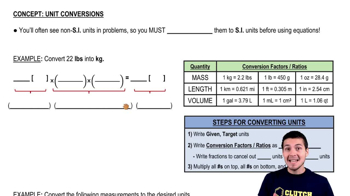Here are the essential concepts you must grasp in order to answer the question correctly.
Work
In physics, work is defined as the energy transferred to or from an object via the application of force along a displacement. It is calculated using the formula W = F × d × cos(θ), where W is work, F is the force applied, d is the distance moved by the object, and θ is the angle between the force and the direction of motion. In this context, the work done by the pitcher on the baseball can be determined by the change in kinetic energy.
Recommended video:
Kinetic Energy
Kinetic energy is the energy possessed by an object due to its motion, expressed mathematically as KE = 1/2 mv², where m is the mass of the object and v is its velocity. In the case of the baseball, as it accelerates to 35 m/s, its kinetic energy increases, and the work done by the pitcher is equal to this change in kinetic energy from rest to its final speed.
Recommended video:
Intro to Rotational Kinetic Energy
Mass and Units
Mass is a measure of the amount of matter in an object, typically measured in kilograms (kg) or grams (g). In this problem, the baseball's mass is given as 150 g, which can be converted to kilograms (0.150 kg) for consistency in calculations. Understanding the units of mass is crucial for accurately applying formulas related to work and energy.
Recommended video:
 Verified step by step guidance
Verified step by step guidance


